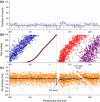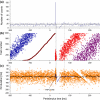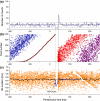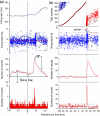Analysis of motoneuron responses to composite synaptic volleys (computer simulation study)
- PMID: 22198533
- PMCID: PMC3282905
- DOI: 10.1007/s00221-011-2987-2
Analysis of motoneuron responses to composite synaptic volleys (computer simulation study)
Abstract
This paper deals with the analysis of changes in motoneuron (MN) firing evoked by repetitively applied stimuli aimed toward extracting information about the underlying synaptic volleys. Spike trains were obtained from computer simulations based on a threshold-crossing model of tonically firing MN, subjected to stimulation producing postsynaptic potentials (PSPs) of various parameters. These trains were analyzed as experimental results, using the output measures that were previously shown to be most effective for this purpose: peristimulus time histogram, raster plot and peristimulus time intervalgram. The analysis started from the effects of single excitatory and inhibitory PSPs (EPSPs and IPSPs). The conclusions drawn from this analysis allowed the explanation of the results of more complex synaptic volleys, i.e., combinations of EPSPs and IPSPs, and the formulation of directions for decoding the results of human neurophysiological experiments in which the responses of tonically firing MNs to nerve stimulation are analyzed.
Figures







Similar articles
-
Computer simulation study of the relationship between the profile of excitatory postsynaptic potential and stimulus-correlated motoneuron firing.Biol Cybern. 2009 Mar;100(3):215-30. doi: 10.1007/s00422-009-0293-x. Epub 2009 Feb 13. Biol Cybern. 2009. PMID: 19214558
-
Computer simulation of the responses of human motoneurons to composite 1A EPSPS: effects of background firing rate.J Neurophysiol. 1997 Jan;77(1):405-20. doi: 10.1152/jn.1997.77.1.405. J Neurophysiol. 1997. PMID: 9120581
-
Synaptic actions of cutaneous A delta and C fibers on primate hindlimb alpha-motoneurons.Neurosci Res. 1986 Jul;3(5):411-29. doi: 10.1016/0168-0102(86)90033-7. Neurosci Res. 1986. PMID: 3748473
-
Effects of large excitatory and inhibitory inputs on motoneuron discharge rate and probability.J Neurophysiol. 1999 Aug;82(2):829-40. doi: 10.1152/jn.1999.82.2.829. J Neurophysiol. 1999. PMID: 10444680
-
Use of spike triggered averaging of muscle activity to quantify inputs to motoneuron pools.J Neurophysiol. 1994 Jul;72(1):248-65. doi: 10.1152/jn.1994.72.1.248. J Neurophysiol. 1994. PMID: 7965009
Cited by
-
Human stretch reflex pathways reexamined.J Neurophysiol. 2014 Feb;111(3):602-12. doi: 10.1152/jn.00295.2013. Epub 2013 Nov 13. J Neurophysiol. 2014. PMID: 24225537 Free PMC article.
-
Are Human Digit Muscles Devoid of Recurrent Inhibition?Front Cell Neurosci. 2016 Jan 11;9:507. doi: 10.3389/fncel.2015.00507. eCollection 2015. Front Cell Neurosci. 2016. PMID: 26793059 Free PMC article. No abstract available.
References
-
- Ashby P, Zilm D. Characteristics of postsynaptic potentials produced in single human motoneurons by homonymous group 1 volleys. Exp Brain Res. 1982;47:41–48. - PubMed
-
- Ashby P, Zilm D. Relationship between EPSP shape and cross-correlation profile explored by computer simulation for studies on human motoneurons. Exp Brain Res. 1982;47:33–40. - PubMed
Publication types
MeSH terms
LinkOut - more resources
Full Text Sources

